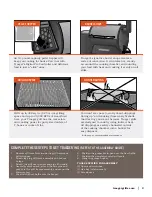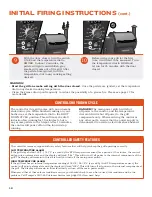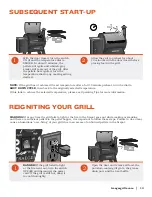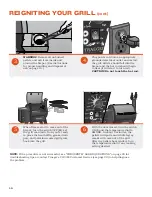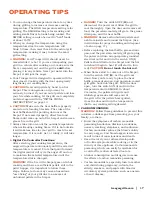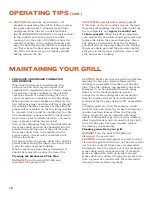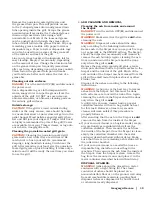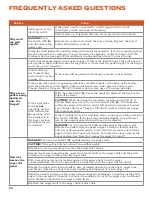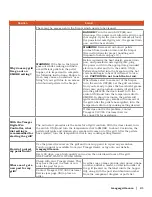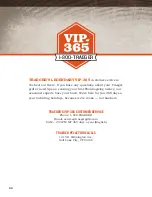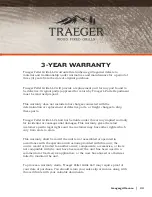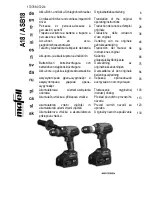
traegergrills.com
|
19
Remove the porcelain-coated grill grate and
the grease drain pan. This will provide access
to the V-shaped grease drain and grease drain
tube opening inside the grill. Scrape the grease
accumulation from inside the V-shaped grease
drain and grease drain tube using a stiff,
nonmetallic tool. Much of the loosened grease
can be pushed down through the grease drain
tube and will fall into the grease bucket. Wipe up
remaining grease residue with paper towels or
disposable rags. Paper towels or disposable rags
can also be used to wipe some of the grease off
of the interior surfaces of the grill.
Line your grease bucket with aluminum foil for
easy cleanup. Empty it occasionally, depending
on the amount of use. Change the aluminum foil
on the grease drain pan frequently (sometimes
after each use, depending upon what was cooked).
Clean foil on the grease drain pan will make
your food taste better and reduce the risk of a
grease fire.
Cleaning outside surfaces:
DANGER!
Turn the switch OFF (O) and disconnect
the power cord.
Use a disposable rag or cloth dampened with
warm, soapy water to wipe the grease from the
outside of the grill. DO NOT use oven cleaner,
abrasive cleansers, or abrasive cleaning pads on
the outside grill surfaces.
Outside storage:
CAUTION!
If the grill is stored outside during
winter or the rainy season, care should be taken
to ensure that snow or water does not get into the
pellet hopper. Wood pellets expand greatly when
wet and will jam your auger. A Traeger Grill Cover
is highly recommended to protect the grill! Covers
are available from your Traeger dealer, or log onto
our website, traegergrills.com.
Cleaning the porcelain-coated grill grate:
CAUTION!
Cleaning the porcelain-coated grill
grate works best while they are still warm. Be
careful not to burn yourself. We recommend
keeping a long-handled cleaning brush near the
grill. After removing your food, give the porcelain-
coated grill grate a quick brushing. It takes only a
minute and it will be ready the next time you want
to use the grill.
2.
ASH CLEANING AND REMOVAL
Cleaning the ash from inside and around
the firepot:
DANGER!
Turn the switch OFF (O) and disconnect
the power cord.
WARNING!
Make sure that the grill is cold before
cleaning the ash.
WARNING!
Disposal of ashes should be done
only according to the following instructions.
Excess ash in the firepot may cause your fire to go
out, especially in the SMOKE setting. The firepot
should be inspected occasionally and cleaned to
remove the ash buildup. Again, cleaning the ash
from in and around the firepot should be done
only when the grill is cold.
Remove the porcelain-coated grill grate, grease
drain pan, and heat baffle to provide access to the
firepot and the interior of the grill. Much of the
ash outside of the firepot can be removed from the
grill with a small metal fireplace shovel or other
similar tool.
Dispose of the ashes according to the following
instructions.
WARNING!
A shop vac is the best way to remove
ashes from the firepot, but this must be done
with extreme care to avoid the risk of fire. Again,
cleaning the ash from the firepot should be done
only when the grill is cold.
A utility-type vacuum cleaner having a metal
collection canister without a bag would be best
for this task. However, almost any vacuum
cleaner will work safely if this procedure is
properly followed.
After ensuring that the ash in the firepot is cold,
vacuum the ash from the inside of the firepot.
a.
If your vacuum cleaner is a bagless model, empty
any previously accumulated debris from the
collection chamber. Then vacuum the ash from
the inside of the firepot. Once the firepot is clean,
empty the collection chamber into the metal
container described below without delay. Make
sure that there is no remaining ash residue left in
the collection chamber.
b.
If your vacuum cleaner is a model that uses a
disposable bag, install an unused bag in the
machine. Then vacuum the ash from the inside of
the firepot. Once the firepot is clean, remove the
bag from the vacuum cleaner and place it in the
metal container described below without delay.
DISPOSAL OF ASHES:
WARNING!
Ashes should be placed in a metal
container with a tight-fitting lid. The closed
container of ashes should be placed on a
noncombustible floor or on the ground, well away
from all combustible materials, pending final
disposal. Ashes are disposed of by burial in soil
or otherwise locally dispersed.





